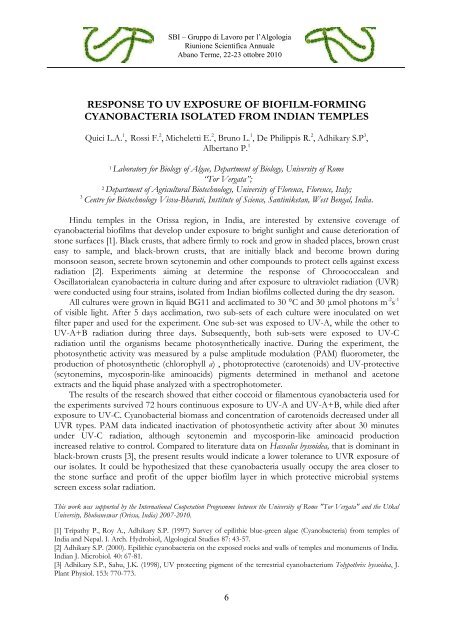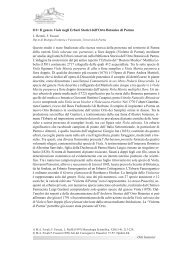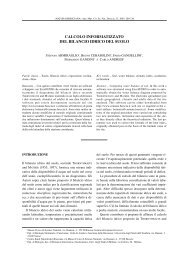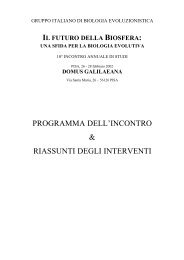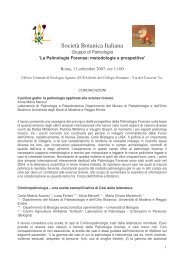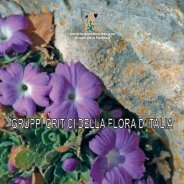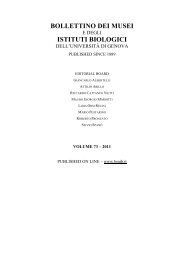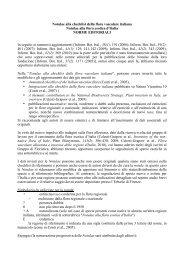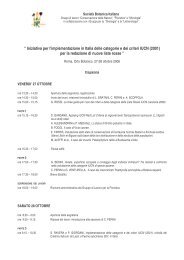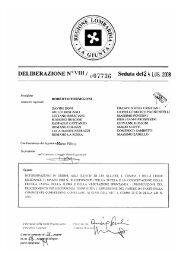Atti Riunione 2010 - Società Botanica Italiana
Atti Riunione 2010 - Società Botanica Italiana
Atti Riunione 2010 - Società Botanica Italiana
Create successful ePaper yourself
Turn your PDF publications into a flip-book with our unique Google optimized e-Paper software.
SBI – Gruppo di Lavoro per l’Algologia<br />
<strong>Riunione</strong> Scientifica Annuale<br />
Abano Terme, 22-23 ottobre <strong>2010</strong><br />
RESPONSE TO UV EXPOSURE OF BIOFILM-FORMING<br />
CYANOBACTERIA ISOLATED FROM INDIAN TEMPLES<br />
Quici L.A. 1 , Rossi F. 2 , Micheletti E. 2 , Bruno L. 1 , De Philippis R. 2 , Adhikary S.P 3 ,<br />
Albertano P. 1<br />
1 Laboratory for Biology of Algae, Department of Biology, University of Rome<br />
“Tor Vergata”;<br />
2 Department of Agricultural Biotechnology, University of Florence, Florence, Italy;<br />
3 Centre for Biotechnology Visva-Bharati, Institute of Science, Santiniketan, West Bengal, India.<br />
Hindu temples in the Orissa region, in India, are interested by extensive coverage of<br />
cyanobacterial biofilms that develop under exposure to bright sunlight and cause deterioration of<br />
stone surfaces [1]. Black crusts, that adhere firmly to rock and grow in shaded places, brown crust<br />
easy to sample, and black-brown crusts, that are initially black and become brown during<br />
monsoon season, secrete brown scytonemin and other compounds to protect cells against excess<br />
radiation [2]. Experiments aiming at determine the response of Chroococcalean and<br />
Oscillatorialean cyanobacteria in culture during and after exposure to ultraviolet radiation (UVR)<br />
were conducted using four strains, isolated from Indian biofilms collected during the dry season.<br />
All cultures were grown in liquid BG11 and acclimated to 30 °C and 30 μmol photons m -2 s -1<br />
of visible light. After 5 days acclimation, two sub-sets of each culture were inoculated on wet<br />
filter paper and used for the experiment. One sub-set was exposed to UV-A, while the other to<br />
UV-A+B radiation during three days. Subsequently, both sub-sets were exposed to UV-C<br />
radiation until the organisms became photosynthetically inactive. During the experiment, the<br />
photosynthetic activity was measured by a pulse amplitude modulation (PAM) fluorometer, the<br />
production of photosynthetic (chlorophyll a) , photoprotective (carotenoids) and UV-protective<br />
(scytonemins, mycosporin-like aminoacids) pigments determined in methanol and acetone<br />
extracts and the liquid phase analyzed with a spectrophotometer.<br />
The results of the research showed that either coccoid or filamentous cyanobacteria used for<br />
the experiments survived 72 hours continuous exposure to UV-A and UV-A+B, while died after<br />
exposure to UV-C. Cyanobacterial biomass and concentration of carotenoids decreased under all<br />
UVR types. PAM data indicated inactivation of photosynthetic activity after about 30 minutes<br />
under UV-C radiation, although scytonemin and mycosporin-like aminoacid production<br />
increased relative to control. Compared to literature data on Hassalia byssoidea, that is dominant in<br />
black-brown crusts [3], the present results would indicate a lower tolerance to UVR exposure of<br />
our isolates. It could be hypothesized that these cyanobacteria usually occupy the area closer to<br />
the stone surface and profit of the upper biofilm layer in which protective microbial systems<br />
screen excess solar radiation.<br />
This work was supported by the International Cooperation Programme between the University of Rome "Tor Vergata" and the Utkal<br />
University, Bhubaneswar (Orissa, India) 2007-<strong>2010</strong>.<br />
[1] Tripathy P., Roy A., Adhikary S.P. (1997) Survey of epilithic blue-green algae (Cyanobacteria) from temples of<br />
India and Nepal. I. Arch. Hydrobiol, Algological Studies 87: 43-57.<br />
[2] Adhikary S.P. (2000). Epilithic cyanobacteria on the exposed rocks and walls of temples and monuments of India.<br />
Indian J. Microbiol. 40: 67-81.<br />
[3] Adhikary S.P., Sahu, J.K. (1998), UV protecting pigment of the terrestrial cyanobacterium Tolypothrix byssoidea, J.<br />
Plant Physiol. 153: 770-773.<br />
6


